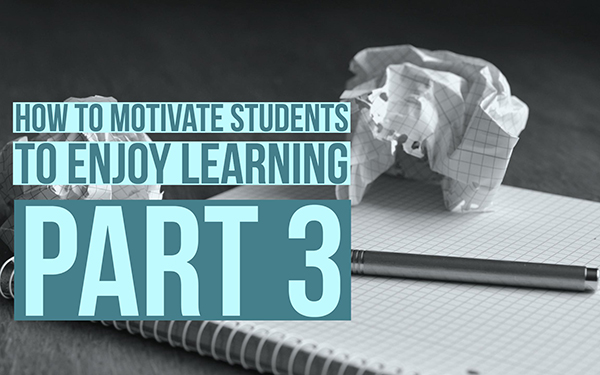How to Motivate Students to Enjoy Learning - part 3
 Lucie Renard —
Lucie Renard —
It has been a while, but I’m back with a new post about the peculiar brain of the student. This blog post series will answer one of the most important questions in education history: =how to motivate students to enjoy learning?
Reading the book “Why don’t students like school” by Daniel T. Willingham inspired me to write a short series of blog posts on this topic. I highly recommend reading this book! (This is the third post in the series, here’s a link to part 1 and to part 2.) You can also find part 4 and part 5 here.
In order to encourage your students to learn, we have to understand their brain and their thinking. How do they think? What do they think about? How does the student’s peculiar brain work?
In this post, my focus is on this important question: “Why is it so hard for students to understand abstract ideas?”
Understanding new things is hard
Every teacher encounters the following problem almost every day. You teach a student a new area calculation that he needs to solve a problem in his own classroom. After a few false starts and a bumpy ride, the student gets it. Yes!
The moment you think your work is done, the student’s brain has a malfunction. He can’t apply the calculation in another situation. He just can’t see how the new problem is related to the one he had just solved. In his mind, he had solved a problem in the classroom, and this problem was about soccer fields.
How come that abstract ideas - for example, the calculation of an area - is so difficult to comprehend? And how come that once the calculation is comprehended, it is difficult to apply when it’s expressed in new ways?

Abstract versus concrete
Abstraction is often used and is actually very standard. You want students to be able to apply learning in new contexts, including those outside of school. The only problem is that the mind hates abstractions. It prefers concrete ideas. When we encounter an abstract idea, such as the formula E = mc2, we ask for a concrete example to help us understand.
“We understand new things in the context of things we already know, and most of what we know is concrete.” - Daniel T. Willingham
The best way to help students understand an abstract idea is to expose them to many different versions of this abstract idea.
Students understand new ideas (things they don’t know) by relating them to old ideas (things they know). That’s pretty obvious. It’s just like the process you go through when encountering a new word like “ab ovo”. You look up the word in the dictionary and see the definition “from the beginning”. You know those words, so now you can understand the meaning of ab ovo. I bet you’ve never looked at it that way. Understanding is remembering in disguise.
Like I’ve already said, students need concrete examples to be able to understand an abstract idea. But concrete examples don’t help much if they are not familiar. Don’t explain the abstract idea by giving an abstract example, or a concrete example, they are not familiar with.
To get a student to understand, you must make sure that the right ideas from the student’s long-term memory are pulled up and put into working memory.

Rote knowledge and Shallow knowledge
You’ve probably noticed that when you ask a question, students answer with the exact words you used when you explained the idea or with the exact words from the textbook. So, you wonder whether he memorized the definition by rote and doesn’t understand what he just said?
When you ask a student to translate a piece of text into Chinese, you will probably receive a correct answer. The student just types in the words in Google Translate and … Padaboom. The Chinese translation appears.
So does your student understand Chinese? Of course not. He got the translation right, but he copied everything from Google Translate.
“Rote knowledge might lead to giving the right response, but it doesn’t mean the student is “thinking”.” - Daniel T. Willingham
Rote knowledge means you have no understanding of the material. You’ve just memorized the words. Whereas rote knowledge is relatively rare, shallow knowledge is more common.
Shallow knowledge means that students have some understanding of the material, but their understanding is limited. You can contrast shallow knowledge with deep knowledge. A student with deep knowledge knows more about the subject. The student understands not just some parts of the subject, but the “whole”. Those students can make links between different contexts. Experience helps students to see deep structure.

Classroom tips for teachers
The message of this post is pretty clear. It’s hard to understand things. And when we finally do, the knowledge seems to be useless in new situations. Deep understanding is a pain in the ass. So what are the implications for the classroom?
1. Provide examples and ask students to compare them
Like you know now, experience helps your students to get deep knowledge. So provide that experience via lots and lots of examples. Asking your students to compare those examples might also help.
How could you explain the concept of “irony”? Take a look at these examples (taken from Willingham’s book)
%note% In Oedipus Rex, the Delphic Oracle predicts that Oedipus will kill his father and marry his mother. Oedipus leaves his home in an effort to protect those he believes to be his parents, but thus sets in motion events that eventually make the prediction come true.
%note% In Romeo and Juliet, Romeo kills himself because he believes that Juliet is dead. When Juliet awakens, she is distraught over Romeo’s death that she commits suicide.
%note% In Othello, the noble Othello implicitly trusts his advisor Iago when he tells him that his wife is unfaithful, whereas it is Iago who plots against him.
By comparing the examples, students might come to see (with some prompting) what each example has in common with the others. A character does something expecting one result, but the opposite happens because he’s missing an important piece of information. Oedipus is adopted, Juliet is alive and Iago is a deceiver.

2. Deep questions for deeper knowledge
What kind of questions do you pose in your class? A lot of them are factual questions, often posed quickly and consecutively. “What does “x” stand for in this formula?” or “What happens when Lisa and Jones get in the car?” Those questions are also important, but it sends a message to students that that’s all there is. That they don’t have to think deeper.
Give your students a challenge. Do their assignments and tests demand deep understanding or is it possible to complete them with just some surface knowledge of the material?
Make sure to test deep knowledge. Students make strong conclusions from the content of tests: if it’s on the test, it’s important! They know that.
3. Keep it realistic
Deep knowledge is your goal. But don’t set the bar too high. Think about what students can achieve, and how quickly they can achieve it. Students only get deep knowledge by hard work and a lot of practice.
Even if your students have only shallow knowledge, that’s much better than no knowledge at all. And you are a step closer to deep knowledge. Keep in mind that it might take years before students develop a deep understanding.
Wrap up
That’s it for this post! I hope you now understand the importance of providing your students with good examples. Delve deeper into this topic by exploring both part 4 and part 5.
Of course, our blog covers several other topics as well. To stay updated, you can follow us on Twitter or join our Teaching with BookWidgets Facebook group. Feel free to find me, Lucie, on LinkedIn. I’m excited to connect with you there!🙌


